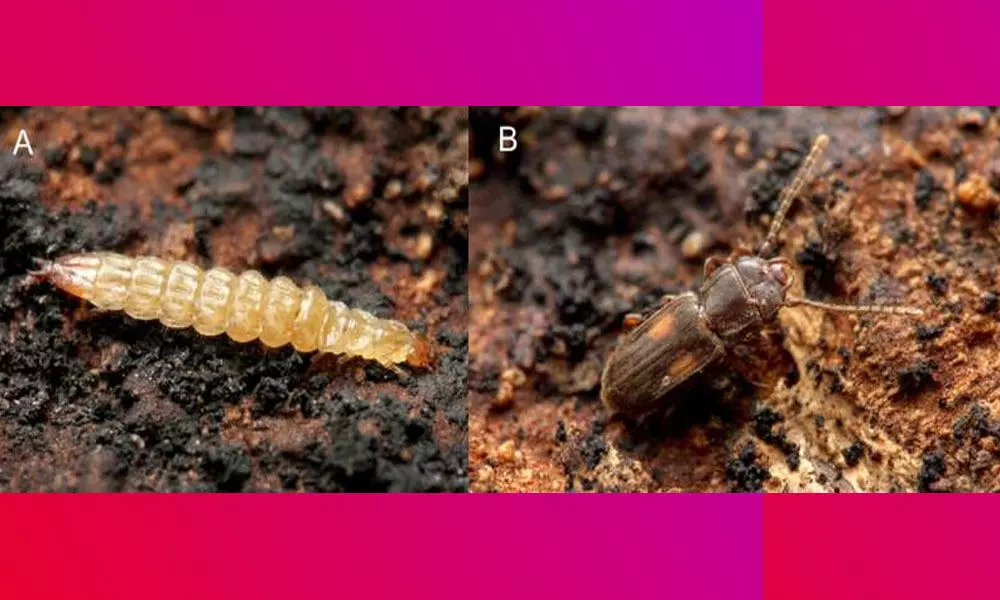Live
- HMPV Outbreaks Spark Global Health Concerns: What You Need to Know
- Gautam Gambhir Faces Criticism Over Tactical Errors in Australia Tour
- CM Revanth Reddy Announces Surprise District Tours Starting January 26
- Telangana's TOMCOM Invites Applications for Driver Jobs in Germany
- Calcutta HC rejects plea by rights body for stall allotment at Kolkata Book Fair
- Bengaluru Beer Prices to Rise by Up to 20% Starting January 20
- My Fans Are Like Disciplined Soldiers: Nandamuri Balakrishna
- Adani Group raises Rs 4,850 crore after selling 13.5 pc stake in Adani Wilmar
- "Jogulamba Gadwal Health Officials Assure Public: No Panic Over HMPV Virus".
- "Charity and Annadanam Program Held on BOSS Hanumanthu Naidu’s Birthday".
Just In
Scientists Revealed The New Jumping Behaviour Of Larvae


A team of researchers has discovered a previously unrecorded jumping behavior in the larvae of a specie (Photo/phys)
- A group of scientists has uncovered a brand-new jumping behavior in insect larvae, and there's evidence that it occurs in a variety of species that hadn't seen it previously.
- The larvae have the ability to spring into the air, wrapping themselves into a loop as they leap ahead. The larvae's ability to make these leaps is what sets them apart.
A group of scientists has uncovered a brand-new jumping behavior in insect larvae, and there's evidence that it occurs in a variety of species that hadn't seen it previously. The behavior was previously unknown in the larvae of a species of lined flat bark beetle known as Laemophloeus biguttatus. The larvae have the ability to spring into the air, wrapping themselves into a loop as they leap ahead. The larvae's ability to make these leaps is what sets them apart.
Matt Bertone, corresponding author of a paper on the discovery and director of North Carolina State University's Plant Disease and Insect Clinic said that jumping is extremely rare among beetle larvae, and the technique they employ to perform their leaps has never been seen before in any insect larvae, as far as they can determine. Other insect species can make incredible leaps, but they rely on a latch-mediated spring actuation system. This simply implies that two portions of the insect's body grab onto one other while the insect exerts effort, accumulating a substantial quantity of energy. The beetle then unlatches the two parts, releasing all of the energy at the same time and allowing it to rise off the ground.
He added that the fact that the L. biguttatus achieves these leaps without latching two portions of its body together is what makes it so extraordinary. Instead, it grips the ground with its claws while building up potential energy, and when those claws let off of the ground, the potential energy is turned into kinetic energy, propelling it skyward. Bertone and co-author Adrian Smith decided to film the behavior to acquire a better understanding of what was going on. That's when they realized how strange the behavior had become. Smith is a research assistant professor of biological sciences at NC State and the director of the North Carolina Museum of Natural Sciences' Evolutionary Biology & Behavior Research Lab.
At first, the manner these larvae were jumping was astounding, but we didn't realize how unique it was until we shared it with a number of beetle experts throughout the country, none of them had ever seen anything like it. The observation of the behavior was a bit of a fluke. Bertone was photographing insect samples he had collected from a dying tree near his lab when he realized that these beetle larvae looked to be jumping.
The scientists recorded the jumps at speeds of up to 60,000 frames per second to figure out how L. biguttatus was able to perform its acrobatics. This allowed them to record all of the jumps' outward movements, implying that the legs were acting as a latching mechanism with the ground. The researchers also measured the larvae's muscle mass to see if they could accomplish their leaps entirely with their muscles rather than relying on a latch mechanism to store energy. They discovered that the larvae lacked the necessary muscle to leap as high or as far as they had been shown jumping. As a result, the larvae's only option was to grasp onto the ground.

© 2025 Hyderabad Media House Limited/The Hans India. All rights reserved. Powered by hocalwire.com






